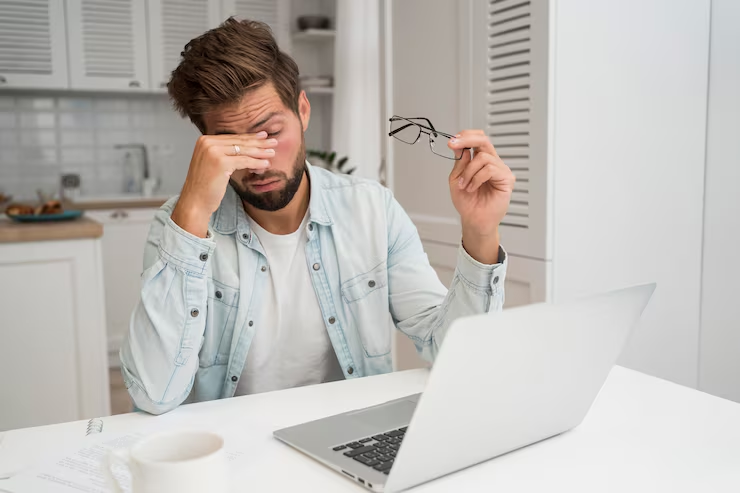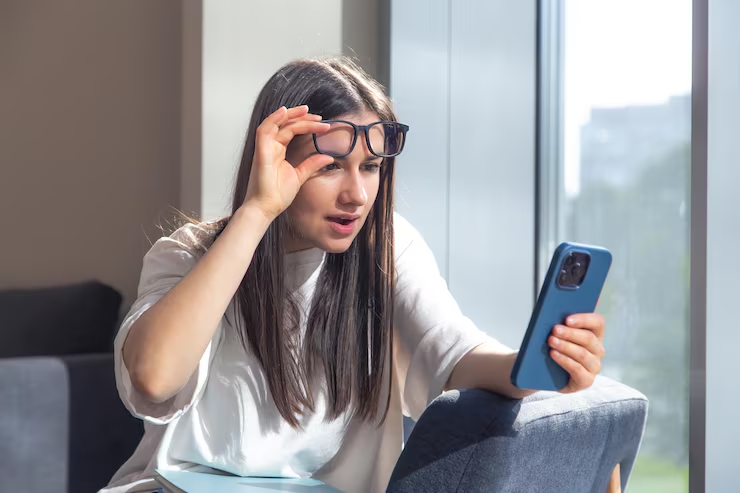n today’s digital-first world, screens are everywhere — from laptops at work to smartphones in our hands and tablets in our homes. While technology keeps us connected and productive, it also brings new challenges to our eye health.
At Eyemastr, we’re seeing more people report discomfort linked to extended screen use a reminder that while digital devices make life easier, they also place growing strain on our vision.

What is Digital Eye Strain?
Prolonged use of digital devices can lead to Digital Eye Strain (DES), also known as Computer Vision Syndrome (CVS). This is not a single condition but a group of vision-related issues caused by excessive screen exposure.
Common symptoms include:
- Eye fatigue or discomfort
- Blurred or double vision
- Dry or irritated eyes
- Frequent headaches
- Neck and shoulder pain
- Difficulty focusing on distant objects after screen use
And it’s not just adults — children, too, are spending more time on digital devices due to online learning and gaming, making them vulnerable to the same strain.
Why Do Screens Affect Our Eyes?
Several factors contribute to digital eye strain:
1. Reduced Blink Rate
When focusing on screens, our blink rate drops by nearly 50%, which can lead to dryness, irritation, and discomfort.
2. Blue Light Exposure
Digital screens emit blue light, which penetrates deep into the eye. Prolonged exposure may contribute to retinal stress and also disrupt natural sleep cycles by reducing melatonin levels.
3. Constant Close-Up Viewing
Holding devices close forces the eyes to work harder, increasing the risk of accommodative stress and fatigue over time.
4. Improper Lighting and Glare
Using screens in poorly lit environments or facing glare makes the eyes strain more, intensifying discomfort.
Long-Term Risks of Digital Eye Strain
While short-term symptoms usually ease with rest, chronic screen exposure can have more serious implications:
- Myopia (Nearsightedness): Rising screen time has been linked to increasing cases of myopia, especially in children.
- Dry Eye Syndrome: Extended device use can worsen dryness, particularly in adults and postmenopausal women.
- Potential Retinal Damage: Some studies suggest that ongoing blue light exposure could play a role in macular degeneration over time.
How to Protect Your Eyes from Digital Devices
You don’t need to give up screens to protect your vision — small, mindful habits go a long way:
- Follow the 20-20-20 Rule: Every 20 minutes, look at something 20 feet away for 20 seconds to relax your eyes.
- Maintain Proper Posture & Screen Distance: Keep your screen at arm’s length and slightly below eye level.
- Control Lighting & Glare: Use anti-glare filters, matte screens, and avoid direct light on your display.
- Use Blue Light Filters: Enable night mode on devices or consider blue-light-blocking lenses for extended use.
When to Seek Professional Help
If you experience persistent headaches, blurred vision, eye pain, or difficulty focusing, it’s time to consult an eye specialist. These symptoms may indicate digital eye strain or an underlying vision condition that needs attention.
Prioritize Your Eye Health
Digital devices are here to stay, but your eye health doesn’t have to suffer. By practicing healthy screen habits and scheduling regular eye check-ups, you can protect your vision in a screen-heavy world.
At Eyemastr, we are committed to helping you see clearly and comfortably — whether it’s through advanced eyewear solutions, protective lenses, or personalized eye care advice.
Take the first step towards healthier vision. Explore our eyewear collection designed to reduce digital eye strain.


